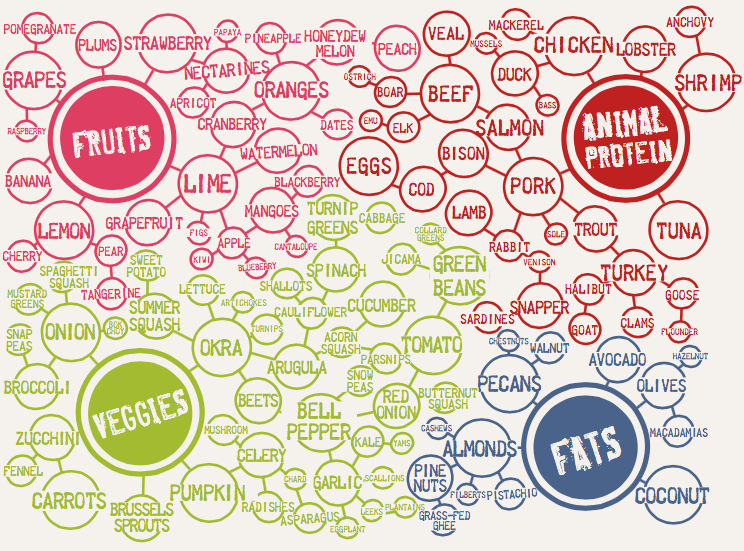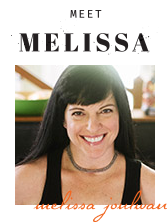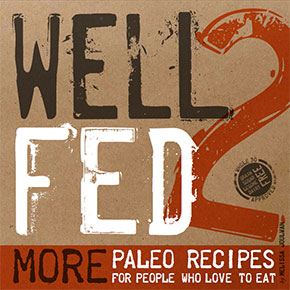Just eat real food (#JERF). The Caveman Diet. Going primal. Living the paleo lifestyle. Around our house we call it “dino-chow.”
All of these terms refer to roughly the same way of eating. They’re based on the idea that we are healthier—both mentally and physically—when we remove inflammatory foods from our diet.
What’s an inflammatory food? The inflamers are foods that were not part of our hunter-gatherer ancestors’ daily meals, but appeared later in history, after agriculture took root. Edibles like grains, dairy, added sugars, and processed foods are the big bullies of the food world, and they’re linked to the “diseases of civilization,” nasty stuff including heart disease, diabetes, autoimmune conditions, and cancers.
When we stop eating those problematic ingredients, we not only fight disease, everything in our lives improves. I know that’s a bold claim, but it’s true! What we put in our bodies forms the foundation for our moods, our energy, our creativity, and our vitality. When we nourish our bodies with paleo-approved foods, our energy levels are better, we look years younger, and we enjoy life more.
The “No” List
Let’s get the bad news out of the way immediately: Eating paleo is probably going to mean eliminating many foods that may top your list of favorites. Different paleo practitioners promote varying guidelines. I endorse and support the standards outlined by Melissa and Dallas Hartwig in their book The Whole30. The guidelines are fairly stringent but extremely practical, and they’re based on the idea that we should eat the foods that make us the healthiest. It’s hard to argue with that.
Each of the “No” foods has its own unique properties that ensure its place on this infamous list. Generally, these foods are excluded because they either negatively affect your metabolism, cause systemic inflammation, or both. Some are so bad that they both wreak havoc on your metabolism and fire up your immune system. We eschew them. (We’re looking at you, grains. We eschew you!)
Processed foods
As a former Doritos diehard, I know it can be hard to give up junk food. But anything found in the middle of the grocery store and sold to you inside brightly colored plastic or cardboard is not a healthy choice.
Added Sugar
All forms of added sugar—even “natural” sugars, like brown sugar, maple syrup, agave nectar, stevia, evaporated cane juice, and honey—are out. Also out are artificial sweeteners like Splenda, Equal, Nutrasweet, and aspartame.
Alcohol
Alcohol has no redeeming nutritional qualities. It’s essentially sugar with a flirtatious attitude. Plus, you have a drink, then your drink has a drink, and soon, you’re face first in a pile of french fries with cheese sauce.
Grains
Despite conventional wisdom, even whole grains are not a good idea. Grains include wheat, rye, bulgur, buckwheat, amaranth, sprouted grains, corn, oats, rice, quinoa, barley, and millet. Avoid them in all their devilish forms: bread, tortillas, pasta, breading on fried foods, and even “healthy” cereals, including oatmeal and granola.
Legumes
Beans—including black, kidney, white, chickpeas, and white—fall into this category, along with lentils, peas, and peanuts, including peanut butter. Legumes like green beans, snap peas, and snow peas are given a green light because they’re more pod than bean.
Soy
Soy is a legume, but I’ve called it out separately because it’s insidious and can be found in unexpected places, like cans of tuna. Avoid soy in all its forms: edamame, soy milk, tofu, meat substitutes, and food additives like soy lecithin.
Dairy
The source doesn’t matter—cow, sheep, or goat—milk and the creamy things made from it are off our plates, including cream, butter, cheese, yogurt, and sour cream. Some primal people eat grass-fed, full-fat dairy; for me, the negatives, like bloating and blood sugar spikes, outweigh the pleasure. One exception is organic, grass-fed butter, but it must be clarified before you eat it. This is known as ghee, and it’s delicious.
Vegetable oils
Basic vegetable oil isn’t made from vegetables at all! It’s off the eating list, along with peanut, canola, sunflower, corn, soybean, and safflower oils. These oils are thugs that beat up on your immune system and promote inflammation.
The “Yes” List
When I tell people I don’t eat grains, sugar, or dairy, they look at me like I’ve got a jailhouse tattoo of Barry Manilow over my heart. Then they ask The Question: “What do you eat?!”
My answer: animals and plants.
Generally speaking, the paleo diet is built around tasty, nutrient-dense foods that began with dirt, sunshine, and rain. They come from the earth, and a person from any time in history would recognize them as food.
It’s just real food: animal-based protein, vegetables, fruits, and natural fat sources. Something like this:
I have to admit, I did find the paleo guidelines a bit restrictive at first, but then I decided to tackle the challenge head on. It was a big surprise to me that I rediscovered the joys of cooking and eating when I embraced the paleo “rules.” I became more creative in the kitchen, and I found ways to recreate my favorite dishes in a much healthier form. I’ve linked to four weeks of meal plans, tips for navigating the world as a paleo eater, and more paleo resources below. But before you jump in, let me tell you more about the Whole30.
About the Whole30
If you’re just getting started with the paleo way of eating, I encourage you to seriously consider committing to the 30-day program know as the Whole30. It will change your life. I know that’s a bold claim, but abiding by the Whole30 guidelines for one month will teach you things about food you didn’t even know you didn’t know.
The Whole30 is a program developed by Melissa and Dallas Hartwig, authors of the books The Whole30 and It Starts With Food (Fun Fact: I developed the recipes for the book, and my husband Dave took the food photos.) I urge you to read their wonderful books. It Starts With Food explains the science behind eating paleo, without getting bogged down in evolutionary details or inexplicable jargon; The Whole30 takes a very practical approach to changing your life. The heart both books is the indisputable fact that some foods make us healthier and some foods do not. Eat more healthy food; eat less unhealthy food.
What could be more simple or make more sense than that?!
By eating only the foods on the “Yes” list for 30 days, you can heal existing inflammation inside your body, learn invaluable information about your own eating habits and overeating triggers, break the grip the Sugar Demon might have on you, and potentially learn how to eat some of the “No” foods once in a while so you can enjoy a treat without doing harm to yourself.
Over the last six years, I’ve done a handful of Whole30 resets myself, and every one of them has been different from the others and incredibly eye-opening and helpful in some way. Sometimes I take on the Whole30 because I need to clean up my act (after a European vacation fueled by schnitzel and beer, for example). Sometimes I go after it because I want to feel reinvigorated or push a little harder to hit my goals at the gym. (Read my Whole30 story.)
If you’ve never tried to give up your evening glass of wine or your Saturday morning pancakes—or you live in a household where other people don’t eat paleo or aren’t taking on the Whole30—I know it probably seems daunting. And I’m not going to lie: It can be very uncomfortable at first. But change is always uncomfortable—and we can’t evolve if we don’t ride out the discomfort.
If you’re a runner or CrossFitter or Zumba-er or workout DVD aficionado, you’ve endured the discomfort of pushups or burpees or a run or [insert your least favorite exercise here] that went on too long. But you did it because you wanted to get better.
If you practice yoga or meditation, you’ve surely felt the discomfort of a pose that seemed endless, or a meditation that woke up feelings you didn’t know you had. But you rode it out because you wanted to learn from it.
Giving up some of your favorite foods—and needing to explain to others over and over again why you’re doing it—might very well be uncomfortable. But I encourage you to do it because you will heal your body; you will learn new things about how and why and what you eat; and, ultimately, you will feel so much better than you do right now.
Here are 30 Reasons to Whole 30. And all my Whole30 recipes.
Free Whole30 Food Plans
Week 1: including recipes like Pad Thai, Chocolate Chili, Italian Pork Roast, and more
Week 2: including recipes like Tah Mahal Chicken, Cinnamon Beef Stew, 5-Spice Pork Ribs, and more
Week 3: lots of tips for how to put together your own plan
Week 4: food tips for closing out your Whole30
Great Ingredients: No Recipe Required: a roundup of meals you can make without a recipe
Whole30 Resources Roundup: handy links to recipes and more to keep you motivated
Well Fed 28-Day Paleo Plan
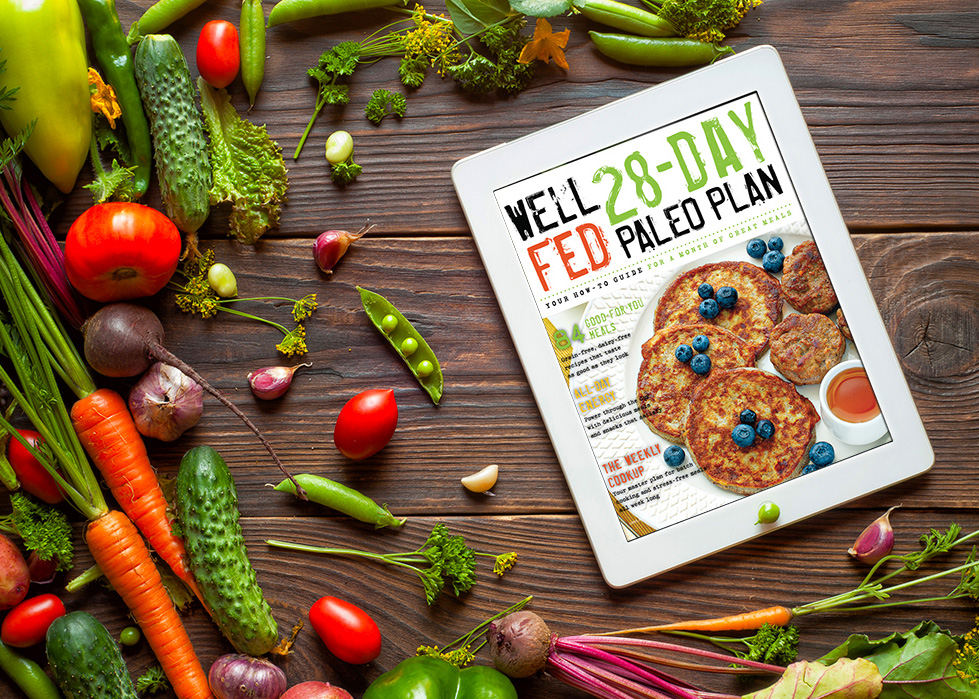
With this meal plan, you’ll eat irresistible food every day—breakfast, lunch, dinner, and snacks. Along the way, you’ll learn how to put together your own meal plans. By the end, you’ll be able to continue your good habits beyond this 28-day plan.
My approach starts with a once-a-week cooking session: The Weekly Cookup. That prepares you for several days of eating without cooking from scratch every time. It also includes recipes that come together in about 30 minutes. Leftovers can be transformed into something new for lunch later in the week. Because nothing kicks off the weekend like a leisurely breakfast, there are also brunch-worthy recipes to start your Saturdays and Sundays right.
Each week of the meal plan includes:
— menus for breakfast, lunch, and dinner—plus snack ideas
— detailed shopping lists arranged by grocery store section
— step-by-step how-to instructions for a Weekly Cookup
— recipes for every dish on the menu
— day-by-day eating and cooking reminders to keep the plan on track
— tips for packing lunches to go
— printable menus, shopping lists, and templates for your own meal plans
Basic Paleo Kitchen Advice
These posts should give you plenty to chew on if you’re ready to make the switch to paleo. From how much meat and produce you’ll need to buy, to being prepared to you never go hungry, to how to season your food with panache.
Stocking Up: just how much food does it take to feed a dino-chow convert?!
The Method Behind My Madness: the foolproof way to make sure you always have something great to eat in the fridge
Taste the Rainbow: veggies and fruits in every color to make sure you’re happy and healthy
Steam/Saute Any Veggie: my fail-proof way to cook almost any veggie
How To Blanch Veggies: par-cook veggies to make dinner super fast
What’s In My Spice Cabinet: must-haves so you can cook up a storm
Herbs vs. Spice: an explanation of the difference between the two, and some of my faves
Tasty Paleo Products: A list of the products I love
10 Fave Paleo Products: Even more paleo goodness
Living Paleo While Still Having Fun
20 Tips to Make Paleo Easier and More Fun: helpful tips from Stephanie Gaudreau (StupidEasyPaleo) and I, from our presentation at PaleoFX 2015
Tips for Eating Paleo in Restaurants: a guide for navigating the world of restaurants so you can eat well, have fun, and not suffer a food hangover
How to Be a Paleo Social Butterfly: five painless tips to ensure your social life doesn’t crash and burn just because you’re taking care of yourself
Hunger vs. Emotional Appetite: a guide to help you wrangle your cravings and differentiate between true hunger and an emotion-fueled appetite
My Cookbooks
My cookbooks Well Fed and Well Fed 2 are both officially Whole30 approved—and Well Fed Weeknights also follow the Whole30 guidelines. Between the three of them, there are almost 500 recipes that are compliant with the guidelines of the Whole30. (An recipes that are not Whole30 approved are marked so you won’t accidentally eat something that’s off-program.)
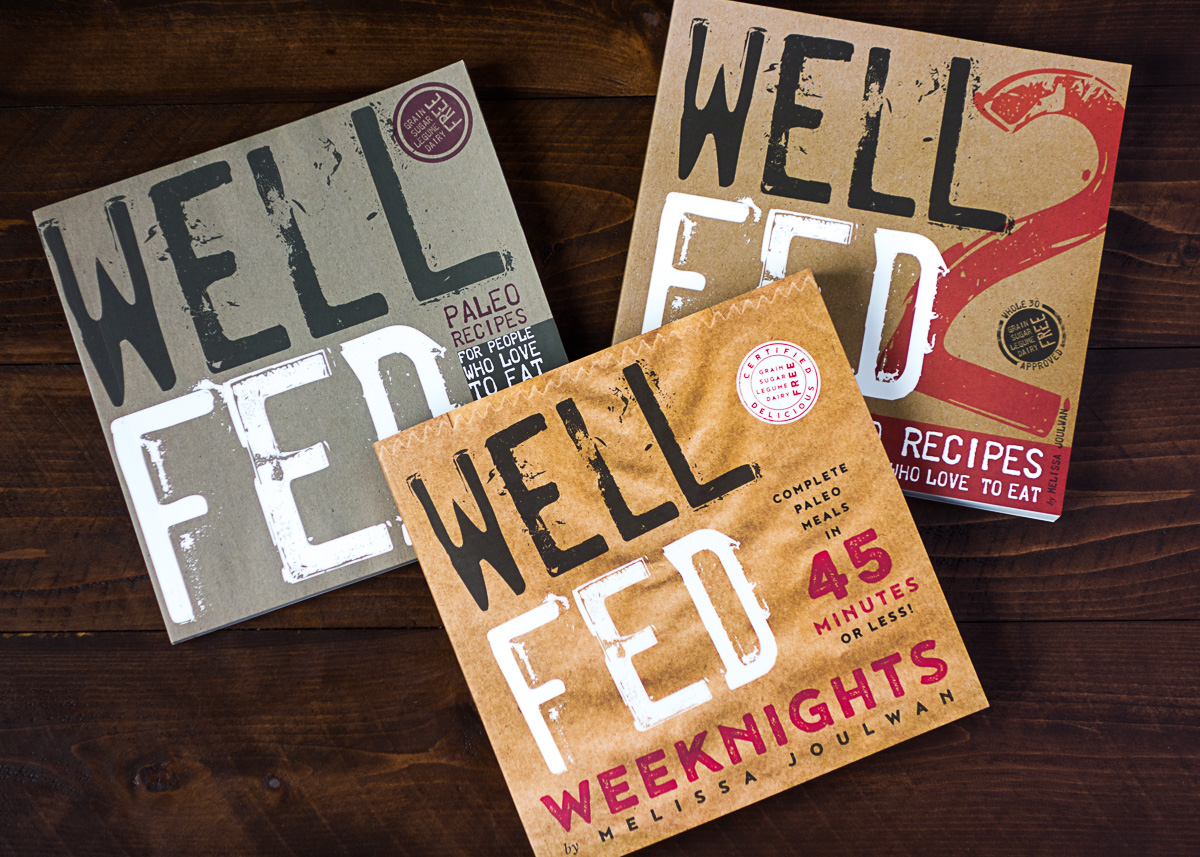
Well Fed Weeknights: Complete Paleo Meals in 45 Minutes or Less
Bursting with vibrant flavors and foolproof recipes, the third installment in the best-selling Well Fed cookbook series puts 128 complete paleo meals on your table in 45 minutes or less. The recipes were inspired by takeout classics, food trucks, and cuisines from around the world. Basically, it’s stuff I’ve eaten—or read about—and wanted to recreate at home. All of the recipes are free of grains, dairy, legumes, and soy.
Every complete meal—a healthy serving of protein with plenty of veggies and luscious fats—is thoroughly tested and easy to make, with affordable ingredients you’ll find at your regular grocery store. And all of the recipes include the popular “You Know How You Could Do That?” variations, as well as Cookup Tips to help shorten meal prep time.
I’ve included instructions for a Mini Cookup with step-by-step instructions for cooking six paleo kitchen staples in under an hour. Cook once, and fancy-up your meals all week long with cauliflower rice, zucchini noodles, homemade mayo, and more.
Debuting in Well Fed Weeknights are fun and flexible Food Court Recipes: blueprints of your favorite dinner themes, like Meat & Potatoes, Burger Night, Velvet Stir-Fry, The Ultimate Salad Bar, and more, all offering basic techniques and creative variations to satisfy your personal cravings.
Help yourself to a free 70-page preview of Well Fed Weeknights—or just go ahead and buy it now!
Well Fed: Paleo Recipes For People Who Love To Eat
My cookbook Well Fed is packed with recipes to make you want to smash in your face with joy and all but one of the recipes are Whole30 approved for use during your Whole30. In addition to recipes for dishes like Shepherd’s Pie, Scotch Eggs, Chocolate Chili, and Bora Bora Fireballs, Well Fed also includes lots of information for how to cook without a recipe — lots of ideas for ways to combine basic protein, veggies, and fats into something special that ensures you won’t get bored and you won’t spend all of your free time in the kitchen. (If you’re curious, the “offender” recipe is a fruit crisp that uses Whole30-friendly ingredients, but is too dessert-y to comply with the spirit of the Whole30. That recipe, however, is just fine for when your Whole30 is complete, and you want a sweet treat.) Help yourself to a free 30-page preview of Well Fed—or just go ahead and buy it now!
Well Fed 2: More Paleo Recipes For People Who Love To Eat
Well Fed 2 is packed with even more recipes and ideas to keep your taste buds happy and all but two of the recipes are Whole30 approved for use during your Whole30. In addition to recipes for dishes like Deconstructed Gyro, Buffalo Chicken Salad, Old School Italian Meat Sauce, and West African Chicken Stew, Well Fed 2 also includes tons more “no recipe required” meal ideas, 15 meatball recipes, 8 dressings and dips based on my homemade mayo recipe (the most popular recipe on my site!), and adaptations to make more than 100 of the recipes compliant with the autoimmune protocol (AIP) of paleo. Help yourself to a free 35-page preview of Well Fed 2—or just go ahead and buy it now!
